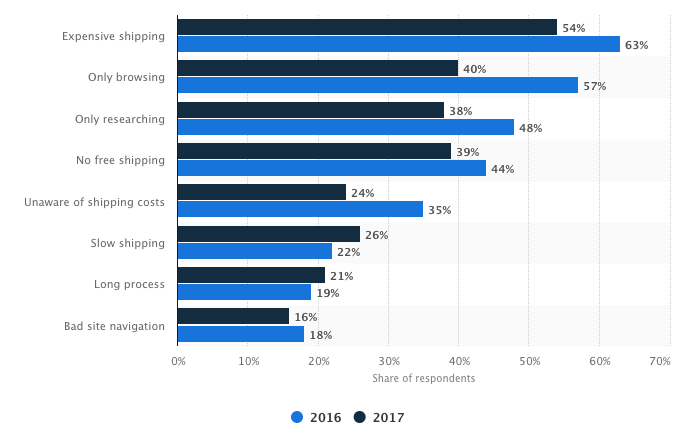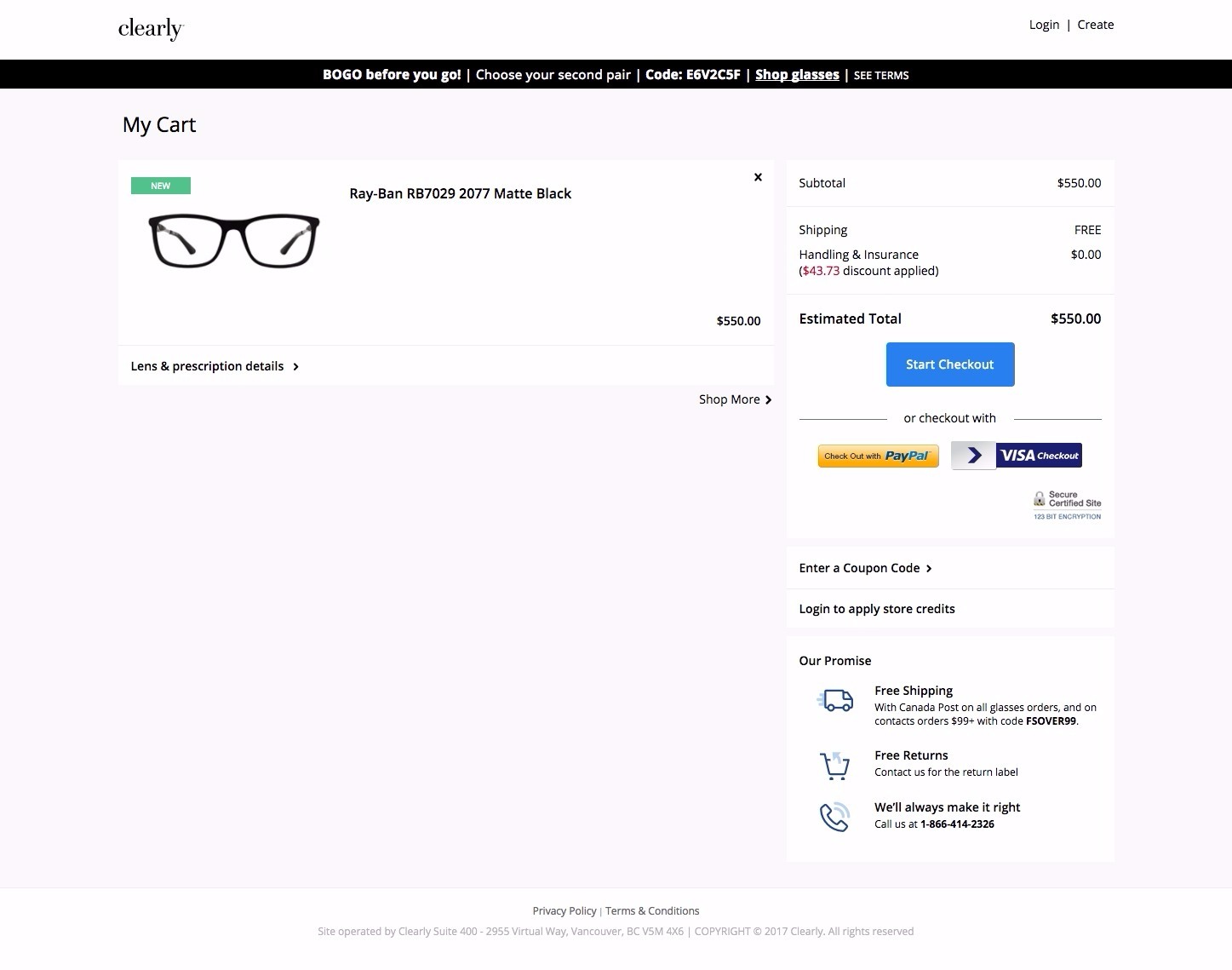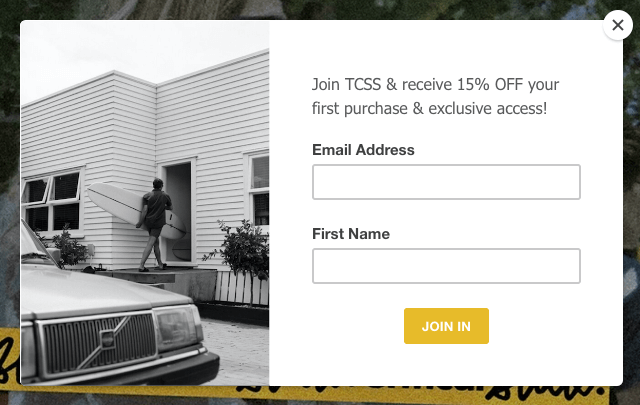What are the reasons people abandon your shopping cart?
If we knew all the reasons someone abandoned a shopping cart, we could address them. Then people wouldn’t abandon their shopping carts. Right?
It’s simple. Bing, bang boom.
Luckily, we know the reasons people abandon their shopping cart.
According to Statista (who know what they’re talking about) it comes down to 8 primary things:
- Expensive shipping
- Only browsing
- Only researching
- No free shipping
- Unaware of shipping costs
- Slow shipping
- Long process
- Bad site navigation
Here’s the graph of how those reasons shake out, and how things have changed in recent years:

Notice it’s mostly about shipping?
This makes sense, right? You display your pricing in your product directory and on the product page. And people who put things in their shopping cart are clearly interested in buying the thing. So it makes sense that the primary reason for not completing that purchase would be costs or complications they didn’t anticipate (namely, shipping, time, and checkout complexity).
So those are the top 8 reasons. Let’s address them and combat shopping cart abandonment, shall we?
Here are the top strategies to do just that.
Shopping Cart Abandonment Strategy: Offer free shipping or a checkout promotion
This strategy addresses reason #1, 4 and 5 in the graph above: essentially combating concerns abcan take the hitout expense and shipping.

Unfortunately, offering free shipping may seriously cut into your profit margins. So there are a few strategies to do this:
- Add the cost of shipping into your prices
- Give free shipping as an incentive for opting in/submitting contact information
- Give free shipping exclusively to first-time buyers, but make account creation mandatory.
Number 1 there could result in a drop in sales, as people may now think your products are overly expensive.
So my recommendation is this: give free shipping exclusively to people who have given you their contact information. Someone whose contact information you have can be more effectively made a loyal customer. This increases their lifetime value, and addresses any profit margin concerns you might have.
Another option is to only allow free shipping for purchases over $X (upper range of your average purchase) – those products where your profit margins are a little healthier and can take the hit.
With this single improvement, you can seamlessly decrease the cart abandonment ratio and improve the shopping cart conversion.
Shopping Cart Abandonment Strategy: Use dynamic retargeting
This strategy (and the one below) address reason #2 and 3 in the graph above, the “only browsing or researching” concerns.
Let’s say I head to an online eyewear retailer, shop around, and add a pair of new ‘specs to my shopping cart:

But then, for whatever reason (perhaps I can’t find my credit card or the cat jumped on my keyboard at an inopportune time), I leave.
Unless that eyewear retailer has my email address (more on that below) they’re out of luck. I’m gone, taking my $550 with me.
Unless.
Unless that eyewear retailer is using retargeting (dynamic product retargeting, if they’re super fancy). This will allow them to follow me around while I peruse the web, and use ads to prompt me to return to my abandoned shopping cart.
On Facebook, that retargeting ad might look like this:

To do it like the eyewear retailer has done above, with the specific product I was looking for in the ad itself, you’ll need to use Dynamic Facebook Retargeting, and that’s a bit more complicated than regular retargeting (which just uses the Facebook pixel to create a custom audience of your website visitors).
I could give you the complete rundown on creating dynamic Facebook retargeting ads, but Steve Chou has done it already in his article “Facebook Retargeting – How To Use Dynamic Product Ads To Generate A 12x Return” and it’s an excellent write-up. So read this article, then head over there to get the walkthrough you can follow.
Related Reading:
For a guide to creating a complete B2C marketing campaign, and effectively using retargeting to recapture lost visitors, check out my article “A Step-by-Step Walkthrough of a Complete B2C Marketing Campaign (Clearly Eyewear).”
Shopping Cart Abandonment Strategy: Get your visitor’s contact information
This strategy, like the one above, addresses those website visitors who are just shopping around.
They abandon your shopping cart not because they’re not interested in buying, or even because the item is too expensive. They abandon because they’re simply no ready to buy.
So keep in touch. Don’t let them slip away.
Send emails, with discounts, value, promotions, whatever. Keep your brand, and the product they liked, at the forefront of their mind.
In order to do that, though, you need to get their contact info (at the very least their email address).
You can do this with required account creation upon checkout, but that will likely drop your website’s conversion rates.
Instead, do it with a popup. Here are a few examples from e-commerce companies like yours:
Here’s an example of an entry popup giving a discount when someone opts in:

And here’s an example of a hello bar on the Frank & Oak website:

And here’s an example of a timed popup from Blue Apron, offering recipes delivered straight to the visitor’s inbox:

Once you have their email address, send them a series of automated emails to drive them back to complete their purchase:
- Email #1: “You forgot something!” – Trigger this email as soon as they leave your site. This is also called an abandoned cart email.
- Email #2: “Are you still interested in [product they abandoned]?” – Send a question-based email a couple days after their initial abandonment. Keep your language personal (in fact, as much personalization as you can give will improve email conversion rates).
- Email #3: “For a limited time, get free shipping on your [product they abandoned]” – Give an offer related to their abandoned product specifically. After all, if they don’t complete the purchase at all, you’ve lost the sale completely.
- Email #4: “Free shipping offer expiring on [[product they abandoned]!” – Add urgency to the buying process
- Email #5: “You’ll lose your [product they abandoned] in 24 hours!” – Add even more urgency to their buying process.
Related Reading:
To get a walkthrough to ecommerce lead generation, check out my colleague’s article “How to Use Popups to Get More Customers for Your E-Commerce Store.” To see more inspirational popup examples, check out “33 All-Star Popup Examples and 5 BIG Lead Generation Takeaways.”
Shopping Cart Abandonment Strategy: Simplify your checkout process
This strategy addresses concerns #7 and 8 in the graph above: “long process” and “bad site navigation.”
Luckily, there’s a company who excels in the checkout process, and we can copy their strategy verbatim: Cards Against Humanity.
CAH is known for its irreverent branding. It’s, perhaps, less known for its excellent sales processes.
Let’s take a look at their checkout process:
What you’re seeing here is, basically, your typical shopping cart checkout process optimized.
They only ask the absolutely necessary questions, and they do it in a way so simple I almost bought their product in the process of taking those screenshots…
Top checkout optimization best practices:
- Make it a multi-step, multi-page process. Don’t show everything at one time or people will be overwhelmed and abandon.
- Ask for the minimum amount of information you need.
- Give a good reason for asking for account creation or contact information.
- Keep the process super clean. Use whitespace and eliminate any distractions.
- Use button text which tells the person exactly what to expect. Avoid “Next” or “Submit.”
- If you offer free shipping or free returns, show that throughout the checkout process.
Final Thoughts
Hopefully these strategies to combat shopping cart abandonment resonate with you and your marketing strategy.
If you have any questions about why people might be abandoning your e-commerce website, and how you can fight back, don’t hesitate to reach out in the comment section. We’d love to check out your site and give feedback.
Related Reading:
- Wishpond’s shopping cart abandonment campaign template
- How to Write The Best Abandoned Cart Emails
- How to Get More Sales from your Ecommerce Product Page
- 30 Reliable Ecommerce Marketing Strategies (With Real-World Examples)
- A Step-by-Step Walkthrough of a Complete B2C Marketing Campaign
- How to Use Popups to Get More Customers for Your E-Commerce Store

